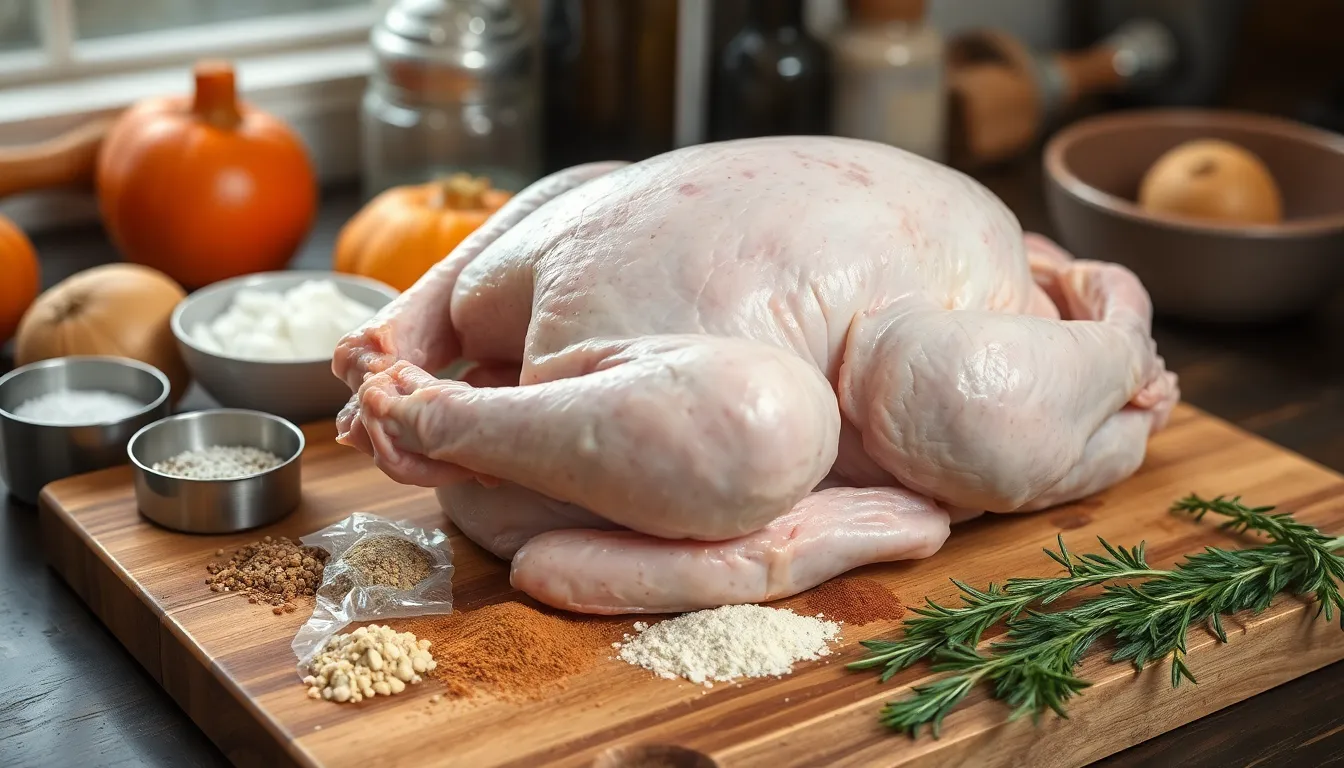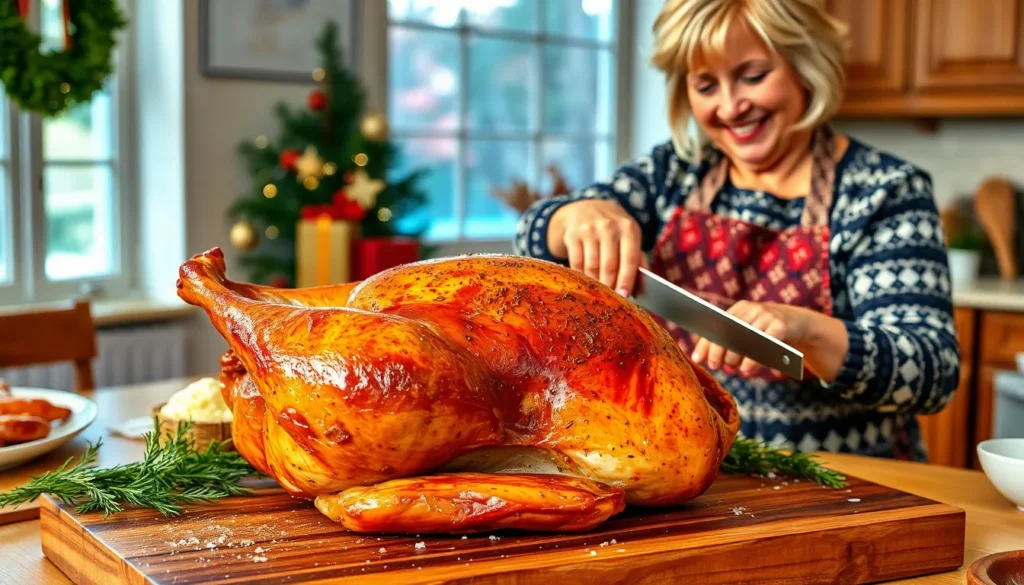Table of Contents
ToggleWhen it comes to holiday feasts, nothing steals the spotlight quite like a perfectly cooked turkey. A juicy turkey can elevate any gathering, leaving guests raving about the meal long after the last bite. However, achieving that mouthwatering tenderness and flavor can feel like a daunting task for many home cooks.
With the right techniques and a little bit of know-how, anyone can master the art of cooking a juicy turkey. From selecting the best bird to employing foolproof cooking methods, this guide will walk through essential steps to ensure a flavorful and succulent centerpiece for any occasion. Say goodbye to dry, bland turkey and get ready to impress with a dish that’s sure to become a family favorite.
Understanding Juicy Turkey
Achieving a juicy turkey involves understanding the fundamental aspects that contribute to moisture retention and overall flavor. Several key factors play critical roles in ensuring a turkey remains succulent throughout the cooking process.
Importance of Moisture Retention
Moisture retention is vital for producing a tender turkey. When moisture escapes during cooking, the turkey dries out, leading to an unappetizing texture. Techniques such as brining or using marinades help to lock in moisture, creating a more enjoyable eating experience. Cooking at the right temperature also aids in retaining juice; higher temperatures can cause moisture loss.
Factors That Contribute to Juiciness
Several specific factors influence a turkey’s juiciness:
- Brining: Soaking a turkey in a saltwater solution enhances moisture and flavor retention.
- Cooking Method: Roasting, smoking, and deep-frying yield varying moisture levels; choosing the right method is essential.
- Temperature Control: Maintaining a consistent cooking temperature prevents moisture loss. Target an internal temperature of 165°F to ensure safety without compromising juiciness.
- Resting Time: Allowing the turkey to rest post-cooking enables juices to redistribute evenly, resulting in a more flavorful outcome.
- Fat Content: A turkey with a higher fat content tends to retain moisture better than leaner varieties.
By understanding these factors, one can effectively enhance the juiciness of a turkey, ensuring a delightful centerpiece during meals.
Ingredients for a Juicy Turkey

Selecting the right ingredients is crucial for achieving a juicy turkey. This section covers essential points regarding the choice of turkey and the seasonings needed for optimal flavor and moisture.
Choosing the Right Turkey
Selecting a fresh or properly frozen turkey significantly impacts juiciness. A bird weighing 12 to 14 pounds is ideal for most gatherings. Look for organic or pasture-raised options when possible, as these tend to have better flavor and texture. Avoid turkeys labeled as “self-basting” since they often contain added sodium and other ingredients that may affect quality. Choose a turkey with a plump appearance and a firm, flexible breast for the best results.
Essential Seasonings and Marinades
Using balanced seasonings and marinades enhances flavor and moisture retention. Recommended seasonings include:
- Salt: Encourages flavor penetration and moisture retention.
- Pepper: Adds a hint of spice without overpowering the turkey.
- Garlic Powder: Offers rich, aromatic flavor.
- Onion Powder: Enhances overall savory notes.
For marinades, consider combining the following:
- Olive Oil: Provides moisture and helps spices adhere.
- Fresh Herbs: Rosemary, thyme, and sage add fragrant, earthy tones.
- Citrus Juice: Lemon or orange juice tenderizes while adding brightness.
Brining the turkey in a mixture that includes water, salt, and spices is an excellent way to lock in moisture. Aim to brine for 12 to 24 hours, depending on the turkey’s size, for optimal results.
Preparation Techniques
Preparation techniques significantly impact the juiciness and flavor of a turkey. Proper brining and seasoning elevate the final dish, ensuring satisfaction during any festive meal.
Brining the Turkey
Brining involves soaking the turkey in a saltwater solution, which enhances moisture retention. A basic brine consists of 1 cup of kosher salt per gallon of water, often infused with spices or herbs for added flavor. Turkeys should brine for 12 to 24 hours, depending on the bird’s weight. This method not only increases juiciness but also enhances the turkey’s overall taste. After brining, rinsing is essential to remove excess salt, followed by thorough patting dry to ensure crispy skin during cooking.
Dry Rub and Marinades
Dry rubs and marinades serve to season and tenderize the turkey. A simple dry rub might include salt, pepper, garlic powder, and dried herbs. Applying this mix evenly across the turkey’s surface maximizes flavor. Marinades, typically a mixture of acid (like citrus juice), oil, and spices, should marinate the turkey for 4 to 12 hours. The acid in marinades helps tenderize the meat while enhancing its flavor. Both techniques allow for creative combinations, making it easy to tailor the taste to personal preferences.
Cooking Methods
Choosing the right cooking method plays a crucial role in achieving a juicy turkey. Two popular techniques include roasting and grilling, each offering unique flavors and textures.
Roasting the Turkey
Roasting provides even heat distribution, resulting in a well-cooked bird with minimal moisture loss. Preheat the oven to 325°F for optimal results. Place the turkey on a rack in a roasting pan to allow airflow. Cooking time typically ranges from 13 to 15 minutes per pound. Basting the turkey every 30 to 45 minutes enhances moisture and adds flavor. Using a meat thermometer is essential; the turkey should reach an internal temperature of 165°F in the thickest part of the thigh. Letting the turkey rest for at least 20 minutes before carving allows juices to redistribute throughout the meat.
Grilling for Extra Flavor
Grilling infuses a smoky flavor while keeping the turkey tender. For optimal results, use a two-zone fire setup: one side hot for searing and the other cooler for indirect cooking. Preheat the grill to medium heat, around 350°F. Place the turkey on the cooler side, ensuring the skin-side is up. Grill for approximately 11 to 13 minutes per pound. Monitor the internal temperature, aiming for 165°F in the thickest part. Adding wood chips during grilling can enhance smoke flavor, contributing to a deliciously juicy turkey. Allow the turkey to rest for 15 to 20 minutes post-grilling for maximum juiciness.
Finishing Touches
The finishing touches elevate a turkey’s presentation and ensure maximum flavor and juiciness. Paying attention to resting and carving techniques enhances the overall dining experience.
Resting the Turkey
Resting the turkey for 20 to 30 minutes after cooking allows juices to redistribute, preventing dryness when sliced. Cover the turkey loosely with aluminum foil to retain heat while allowing some steam to escape. During this period, flavors intensify, resulting in a more enjoyable eating experience. Avoid skipping this step, as it directly impacts the turkey’s juiciness, ensuring each slice remains moist and flavorful.
Carving Techniques for Juiciness
Employing proper carving techniques enhances the turkey’s juiciness and visual appeal. Use a sharp carving knife for clean cuts. Start by removing the legs at the joint, ensuring a generous cut along the thigh. For the breast, slice horizontally across the grain, allowing juices to stay intact. Carve in thick slices while maintaining skin for added flavor. Presenting turkey with skin intact makes for an appealing dish and reinforces juiciness, resulting in a memorable holiday meal.
Crafting a juicy turkey is an art that transforms holiday meals into unforgettable experiences. With the right techniques and a focus on moisture retention cooks can elevate their turkey from ordinary to extraordinary.
From selecting the ideal bird to mastering brining and cooking methods every step plays a crucial role. Resting the turkey is equally important ensuring that each slice bursts with flavor and juiciness.
By applying these insights anyone can create a centerpiece that not only impresses guests but also becomes a cherished family tradition. With practice and attention to detail the perfect juicy turkey is within reach.




